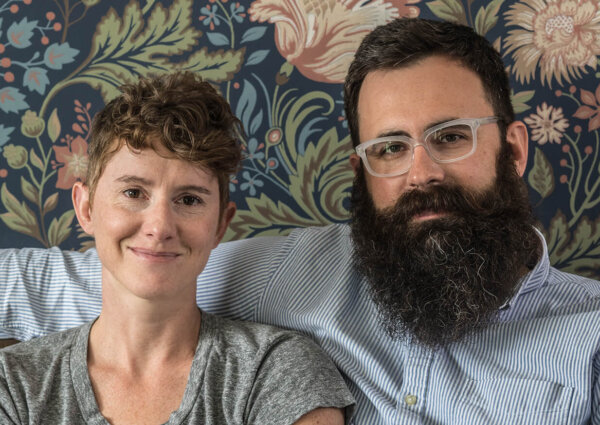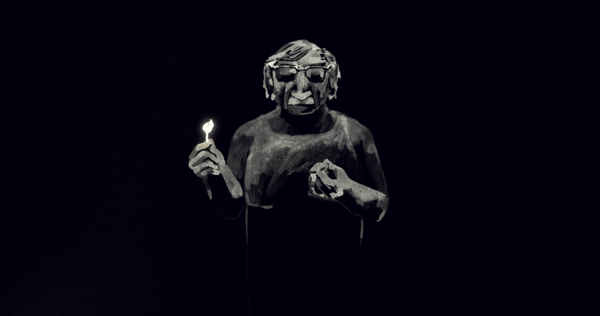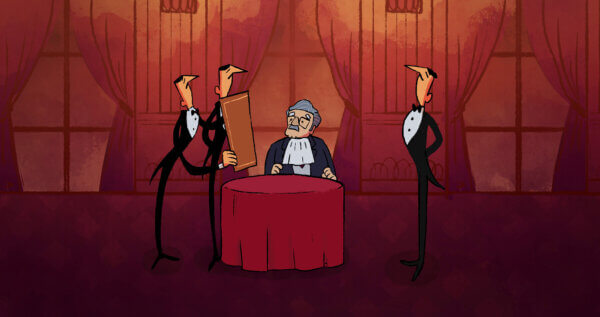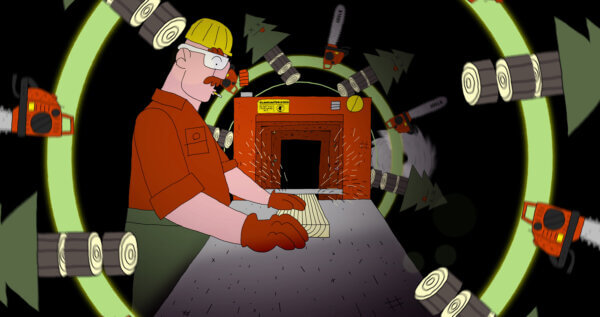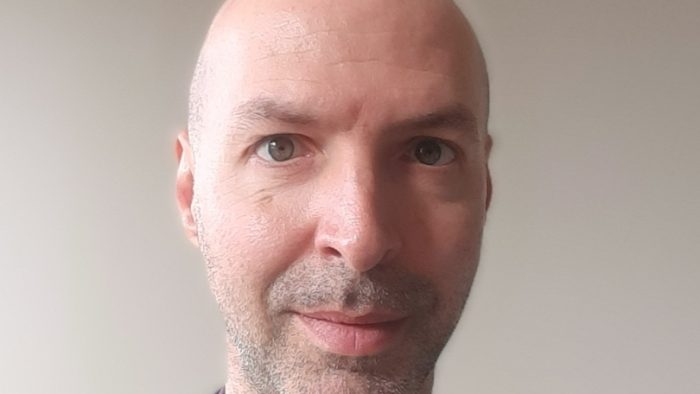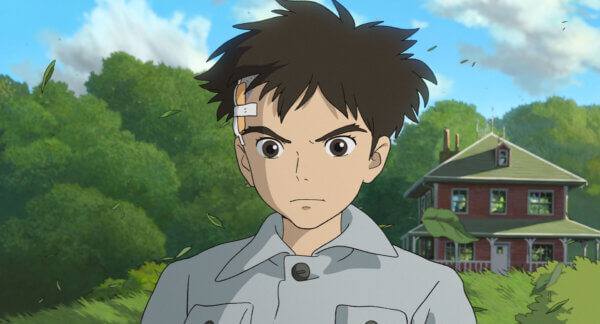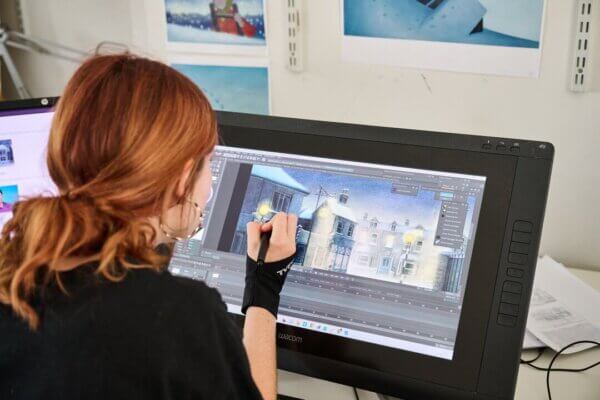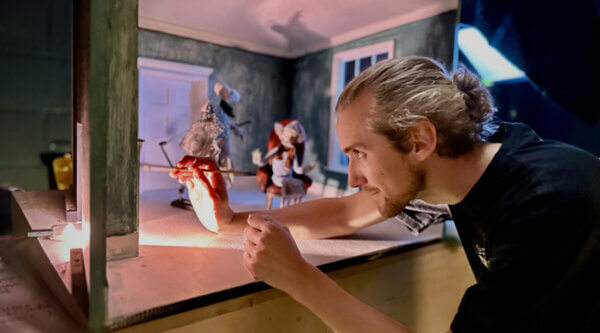You have probably seen a live-action movie from the minds of Jared and Jerusha Hess. Their knack for capturing offbeat characters have given us many modern cult classics, from Napoleon Dynamite and Nacho Libre to more under-the-radar fare like...
You have probably seen a live-action movie from the minds of Jared and Jerusha Hess. Their knack for capturing offbeat characters have given us many modern cult classics, from Napoleon Dynamite and Nacho Libre to more under-the-radar fare like Gentlemen Broncos and Austenland. However, with their latest project, the two join a long list of filmmakers transitioning into the world of animation. Their short film, Ninety-Five Senses, sees the duo helm a more dramatic story, brought to kinetic life through the power of hand-drawn and hand-painted work from a diverse team of animators around the globe.
“The film was initially pitched to us as a project where we could collaborate with up-and-coming animators, and that was what really excited us,” Jerusha explains. The film was commissioned by Utah’s Salt Lake Film Society as part of their program MAST, short for Media Accelerator Studio, a program pairing seasoned filmmakers with fresh talents. “We always love mentoring and collaborating with new voices, so we were super pumped.” The Hesses were given the opportunity to work with several artists at once, which required a story that could contain several different styles.
In response, they re-teamed with long-time collaborators and screenwriters Hubbel Palmer and Chris Bowman, who conceived the idea of splitting the film by way of the five senses: sight, smell, touch, taste, and hearing. “They wrote the film in these different chapters hitting the different senses, and then we knew that we had to ground it by coming back to the main character, Coy,” explained Jared. Voiced by Tim Blake Nelson in a warm Southern drawl, Coy is an older gentleman reminiscing about his life through the lens of each sense, recalling memories both good and bad.
Ninety-Five Senses is a resonant story of emotional regret and spiritual redemption that has captured the industry’s attention. It was officially included in the Academy Awards’ shortlist for Best Animated Short Film this past week, proving to be a strong contender following festival wins at Cannes, Florida, Toronto, and Amsterdam. “It was just an amazing opportunity to collaborate with these animators,” Jared said. “They are all amazingly talented people.”
Skwigly sat down with Jared and Jerusha Hess to discuss the film’s conception, working with their eclectic animation team, and what brought them to the world of animation. Here is our conversation, edited for length and clarity.
I guess this is the most boring way to start, but I’m curious how this even happened! Ninety-Five Senses is the first animated film that you two have co-directed. Disregarding the story of the short itself, what inspired the decision to transition into animation?
Jerusha: The film was initially pitched to us as a project where we could collaborate with up-and-coming animators, and that was what really excited us. The Salt Lake Film Society [based in Salt Lake City, Utah] was starting this new program called MAST [short for Media Accelerator Studio] which pairs filmmakers who are in the business with up-and-coming filmmakers. We always love mentoring and collaborating with new and fresh voices, so we were super pumped. We got to work with animators that were local to Utah and ones that were all over the world. It was during COVID, so it was kind of a quiet time and we were like, “Yes, let’s do it!”
Jared: Interestingly enough, Jerusha and I have an animated movie for Netflix called Thelma the Unicorn coming out next year, which is a feature. We had been writing animated stuff for a long time and we were in the process of amping up work on that project as well. But, as Jerusha said, it was just an amazing opportunity to collaborate with these animators, some who were fresh out of film school and others who were independent animators throughout the world. They are all amazingly talented people.
You guys are joining a long line of live-action filmmakers who recently have begun exploring animation and now never want to leave. [laughs] For you two, what fostered that love for animation to the point where you wanted to make something animated?
Jared: I feel like our live action movies have always been big cartoons anyway, so given how extreme and strange our characters are, it’s always felt like a good fit. I’ve always loved animation.
Jerusha: We might have joined the ranks of animators, but we’re not saying goodbye to live-action anytime soon. A live-action indie will take 23 days to make and an animation takes three years. [laughs]
That’s a great point, we don’t want to see you backing away from either medium! Are there any films or animators that you love or have inspired you?
Jerusha: I think we both really loved all the Hanna Barbera stuff. Pixar came to life when we were young adults and of course that blew our freaking brains.
Jared: For me, Disney’s Robin Hood, and Saturday morning cartoons in the 80s and 90s. Um,
Jerusha: I’m not an animation expert at all. I really just love stories and comedy, so whatever the form is that I consume my stories, it doesn’t matter to me.
Did Coy’s story come with that initial pitch or was that developed later on?
Jerusha: We collaborated with Hubbel Palmer and Chris Bowman, writing partners who we’ve written several projects with.
Jared: We went to film school with them, so we’ve known him for a long time.
Jerusha: They’re really smart and funny guys. They came on board to write a script. We didn’t really know what they were doing until we saw it and we were blown away.
Jared: Because we knew that we were going to be assigning different groups of animators with totally different styles their own chapters [in the film], Hubbel and Chris knew they had to write something that would work with five or six different styles of animation and still feel cohesive. They wrote the film in these different chapters hitting the different senses, and then we knew that we had to ground it by coming back to the main character, Coy, who’s telling a story. Daniel Bruson, an animator living in Brazil, did [those sequences]. I mean, we could talk about the animators for days.
Well, let’s do it! The juxtaposition between the different styles is immediately striking and it makes my heart sing to hear that it all came from independent animators. As amazing as that is, I imagine it was daunting to have all of these different voices contributing to one single project. Was there one unifying thing that kept everyone going in a similar direction?
Jerusha: We chatted a lot before anyone started animating. They pitched us their ideas and we’d get excited about one thing and we’d go from there. I think the tricky part––it wasn’t even tricky––the fun part was asking “How do we make Coy look similar in each person’s style?” We had an image that everyone was going off of, but then they all were watching each other’s [segments] to see what was happening. The transitions in and out of each chapter was the only part that we needed to get in the mix of. Otherwise, these were really brilliant, exciting storytellers who pitched the heck out of each section.
Jared: In addition to the character design, I think one thing that grounded everything was Tim Blake Nelson’s performance.
Jerusha: Oh yeah, absolutely.
Jared: Once we recorded him and put together an edit of the monologue, it really informed everybody’s work and set the tone for the piece. It was a real unifying factor where everything felt cohesive despite all the different styles.
Were you guys given the opportunity to decide which animators you would be working with?
Jared: Yeah, we were able to pick different ones and then assign them to the different senses and that was a lot of fun.
Jerusha: We saw their samples and they each spoke to different sections. Daniel Bruson does these hand-painted, beautiful watercolors. We probably asked too much of him because each interstitial took him forever to do, but we knew he had a powerful style to be the connective tissue.
Jared: We had Gabriela Badillo in Mexico City with her group of female animators who were just phenomenal. They did the touch sequence, where he’s dreaming about what his life could have been like. It was so lyrical the way that they put it all together.
Jerusha: The animators who did smell, Jared Mathews and Dallin Penman, are an animating duo from Utah and they were just finishing up school at the time. They were still in college and their sample work was so funny. They’re really great storytellers and they came up with a really clever and funny section. But then, at the end, it’s really poignant. Casey Tobey was another Utah animator who did taste. That section has been described as a literal palette cleanser because suddenly it becomes very light and silly. His animation worked really great for that as well.
Was it at all intentional for the interstitials to have a calmer palette than the sense sections? When we see Coy in the present, it definitely has a unique effect as opposed to experiencing the livelier, more unique animation of the senses.
Jared: Yeah, definitely. There’s a warmth to the character, he feels like he could be somebody’s grandfather. For the story to work, you need to really like him and feel for his situation. As you’re going through all of these sequences, it’s good to be grounded and able to reset before you launch into the next one.
Jerusha: It needed to feel bleak, but he still needed to feel very much alive. The fact that the image is moving so much because you see all the lines, I think that gives him all this life even though he’s just in front of a blank wall.
The character of Coy is such a specific design. Where did the inspiration for that character come from? Was it a kind of chicken and the egg situation between your designs and Tim Blake Nelson’s recording? Did he have any influence?
Jerusha: I think a little bit of both. Jared and I collect people all the time. We’ll be at the State Fair and we’ll see someone’s haircut and we’re like, “Oh, that’s got to go in a movie.” I think faces are very important to us, so knowing exactly what our character is going to look like is big. I’m sure Tim’s monologue did have an influence, but I had a specific look I was going for. I found a really cool photo of some older gentleman in Eastern Europe where I was like, “This is what I’m going for.”
Jared: We had a design ready to go and we actually shared it with Tim when we started recording. It definitely informed how he brought him to life, which was super cool. Tim grew up in Oklahoma, so he was able to really channel that authentic drawl, which was crucial.
That transitions into talking about Tim Blake Nelson, who provides such an anchor for the story. How did he get involved with the project and what were his first thoughts after he was approached?
Jared: We’d never worked with him before but we were massive fans of everything that he’s done: all of his work with the Coen Brothers, HBO’s Watchmen, and my personal favourite, the movie Heavyweights. [laughs] He’s in the beginning of that film showing the video about the camp. Anyway, we reached out and sent him the script. He fell in love with it and was excited to work with us. It all happened pretty quick. He was so passionate and thoughtful about every moment, and that’s what you want. He was just fully invested in making sure every little word sounded right. It was just amazing to work with him.
Jerusha: He’s just a delightful, very generous, and lovely human. When you read the script in its initial stages, all you would be able to hear was his voice, so it’s great that he ended up doing it.
Jared: I think he amused the writers as well, hearing it in his voice. It all worked out great.
You both have these legendary live-action films that have generated strong cult followings, but now, with your animated work, it feels like you’re ushering into a moment where there’s an even wider range of stories you can tell. Is there still an underlying theme in the stories you are attracted to, animated or otherwise?
Jared: I have an affinity for outcasts. At the end of the day, learning the stories of people that you don’t typically see on screen is always what interests me.
Jerusha: This might just be a normal writing trope, but we really love the underdogs. All of our movies are going to keep featuring underdogs and––Jared’s right––shining a light on people who wouldn’t normally get a light shone on them. That’s what gets us excited. When we’re at the State Fair, we’re looking for that person.
Ninety-Five Senses will be released on a date yet to be announced.
The post Ninety-Five Senses | Interview with Co-Directors Jared and Jerusha Hess appeared first on Skwigly Animation Magazine.




